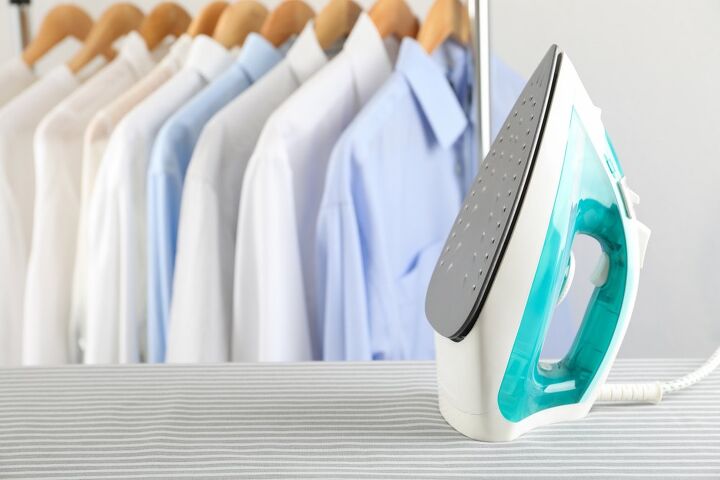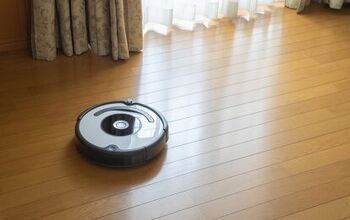Can You Wash Ironing Board Covers? (Find Out Now!)

While ironing might not be everyone’s favorite chore, it’s sometimes part of the laundry process. Maintaining your ironing board and washing your ironing board cover are essential to keep your clothes from getting dirty all over again.
Many ironing board covers are hand- or machine-washable, but you should always check the care label before washing. Using mild detergent and cold water, wash the cover on a gentle cycle. If your cover is not machine washable, spot treat as needed. Ironing board covers should not go in the dryer as the heat could damage them.
Why Wash an Ironing Board Cover?
You’re presumably putting clean clothes on your ironing board, so why would you even need to wash the cover? I’ll answer your question with another question: how often do you actually iron? I doubt many of us iron every day (more power to you if you do!).
Even if you iron weekly, your ironing board is sitting unused for a period of time, gathering dust. Did you get any water on the cover from the last time you steam-pressed your clothes? What about those spots of starch hanging out on the cover?
Washing the ironing board cover means a cleaner surface for your clean clothes.
Check the Care Label
Regardless of the item, the care label is the first place to check for washing and drying instructions. Things like kitchen mats and even ironing board covers might seem like they can go in the wash, but the care label may say otherwise. Always check the label first!
The care label is usually on the inside of an ironing board cover. Remove the cover from the ironing board and read the label for instructions.
Machine Washing Ironing Board Covers
Your ironing board cover is machine washable! Huzzah! In order to give it the longest life possible, wash the cover in cold water with mild detergent on a gentle cycle.
If it’s extra dirty, you may want to wash it alone. Otherwise, put it in a load with like materials, such as sheets and pillowcases.
Hand Washing Ironing Board Covers
If your ironing board cover is hand wash only, the care label will specify it.
For a quick hand wash:
- Remove the cover from the ironing board frame.
- Wet a sponge with cold water and apply mild detergent.
- Wring out excess water and detergent before wiping the ironing board cover.
- Thoroughly rinse the soap out of the sponge, and wipe the cover until no soap is left.
- Hang dry.
For a deeper clean:
- Fill a tub with cool water and mild detergent.
- Submerge the ironing board cover and swirl it around to work the soap into the material.
- Drain the tub and replace it with clean water.
- Rinse the cover.
- Repeat the rinsing process until no soap is left on the cover.
- Hang dry.
Spot Cleaning Ironing Board Covers
It’s a sad day when something isn’t machine washable. It’s even sadder if hand washing is out of the picture, too. But if your ironing board cover falls into this category, you don’t have to iron in filth!
Spot cleaning is when you treat a soiled area with a small amount of water and detergent. This is the appropriate cleaning method for covers that can’t be washed. It’s also a good idea to spot clean materials that can be washed in between cycles.
Similar to the quick handwashing method, spot cleaning is simply done on a smaller scale. Rather than wipe the whole cover, you treat only the soiled area with a small amount of water and detergent.
Spot Cleaning Starch
When starch dries, it creates a sticky spot on your ironing board cover. In a spray bottle, create a solution of 1 cup of water, 1 cup of vinegar, and 3 tablespoons of baking soda. Spray this solution on the starchy stains, and let it sit for a few minutes. Then, wipe it with a damp cloth.
Drying Ironing Board Covers
Although many ironing board covers are machine washable, you should never dry one in a dryer. The heat from the dryer often damages the material.
Instead, hang the ironing board cover to dry it. If it’s a nice day, you can hang it outside in the fresh air and sunshine. Otherwise, hang it in a room with good air circulation.
It’s important to let the cover dry completely before replacing it on the ironing board.
Additional Tips
When replacing the newly washed and dried cover onto the ironing board, pull it tightly across the frame. Put your iron on the highest setting. Iron the cover while on the frame to remove any wrinkles and create a smooth surface for future ironing.
Unless you’re actively ironing the cover as explained above, keep the face of the iron off the ironing board cover. The hot iron could damage the cover or the pad underneath. It could even start a fire.
Related Questions
Do you have more questions about how to care for ironing board covers? You’ve come to the right place! Keep reading for additional advice.
How long does an ironing board cover last?If you iron weekly, you should replace the cover every 3 years. The cover will last longer if you don’t iron as much.
What is an ironing board cover made out of?Ironing board covers are made from a variety of materials. Most commonly, you’ll find them in some type of durable cotton or cotton blend. If you’re making your own cover or looking to purchase a new one, consider the color as well as the fabric. Darker colors are better for hiding stains.
Summary
The care label of an ironing board cover is the best place to look for washing and drying instructions. While many covers can be machine or hand-washed, some should only be spot cleaned.
It’s never advised to put an ironing board cover in the dryer as the heat may damage the cover. Rather, hang the cover to dry and make sure it’s completely dry before replacing it on the ironing board.

Brigid Levi is a wife, mother, and freelance writer who enjoys a good DIY project and creating beautiful spaces within her home. From cleaning and organization hacks to home decor ideas, she loves helping people in their quest to turn a house into a home. Her hobbies include pretending to be Joanna Gaines while updating her home with her husband and performing in local theater productions.
More by Brigid Levi



























